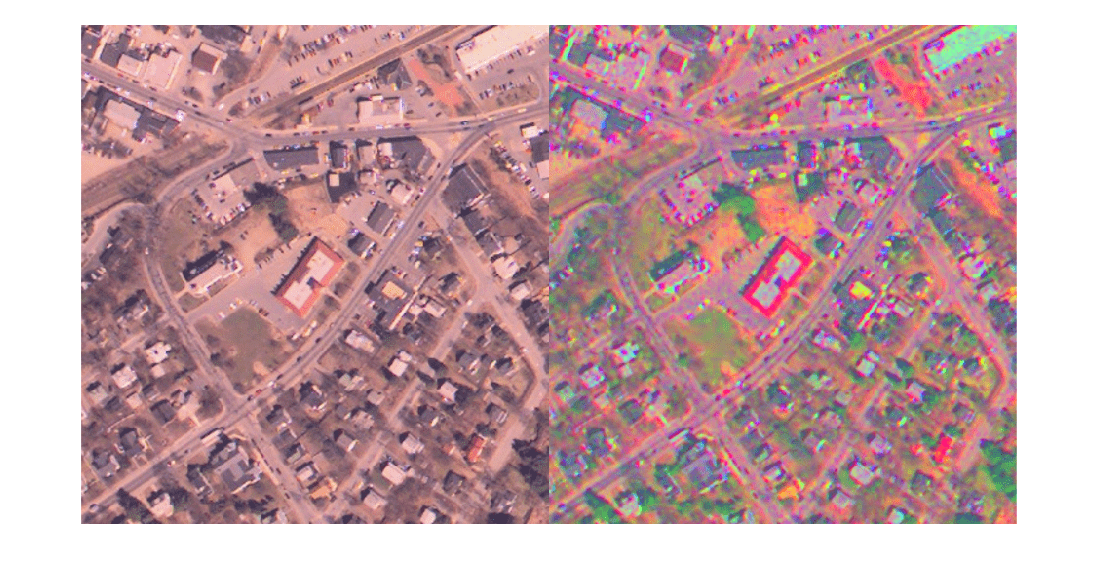decorrstretch
Apply decorrelation stretch to multichannel image
Description
S = decorrstretch(A)A and returns the
result in S. The mean and variance in each band of S
are the same as in A.
The primary purpose of decorrelation stretch is visual enhancement. Decorrelation stretching is a way to enhance the color differences in an image.
S = decorrstretch(A,Name=Value)
Examples
Input Arguments
Name-Value Arguments
Output Arguments
Tips
The results of a straight decorrelation (without the contrast stretch option) may include values that fall outside the numerical range supported by the class
uint8oruint16(negative values, or values exceeding255or65535, respectively). In these cases,decorrstretchclamps its output to the supported range.For class
double,decorrstretchclamps the output only when you provide a value forTol, specifying a linear contrast stretch followed by clamping to the interval[0 1].The optional parameters do not interact, except that a linear stretch usually alters both the band-wise means and band-wise standard deviations. Thus, while you can specify
TargetMeanandTargetSigmaalong withTol, their effects will be modified.
Algorithms
A decorrelation stretch is a linear, pixel-wise operation in
which the specific parameters depend on the values of actual and desired
(target) image statistics. The vector a containing
the value of a given pixel in each band of the input image A is
transformed into the corresponding pixel b in output
image B as follows:
b = T * (a - m) + m_target.
a and b are nBands-by-1
vectors, T is an nBands-by-nBands matrix,
and m and m_target are nBands-by-1
vectors such that
mcontains the mean of each band in the image, or in a subset of image pixels that you specifym_targetcontains the desired output mean in each band. The default choice ism_target = m.
The linear transformation matrix T depends
on the following:
The band-to-band sample covariance of the image, or of a subset of the image that you specify (the same subset as used for
m), represented by matrixCovA desired output standard deviation in each band. This is conveniently represented by a diagonal matrix,
SIGMA_target. The default choice isSIGMA_target = SIGMA, whereSIGMAis the diagonal matrix containing the sample standard deviation of each band.SIGMAshould be computed from the same pixels that were used formandCov, which means simply that:SIGMA(k,k) = sqrt(Cov(k,k), k = 1,..., nBands).
Cov, SIGMA, and SIGMA_target are nBands-by-nBands,
as are the matrices Corr, LAMBDA,
and V, defined below.
The first step in computing T is to perform
an eigen-decomposition of either the covariance matrix Cov or
the correlation matrix
Corr = inv(SIGMA) * Cov * inv(SIGMA).
In the correlation-based method,
Corris decomposed:Corr = V LAMBDA V'.In the covariance-based method,
Covis decomposed:Cov = V LAMBDA V'.
LAMBDA is a diagonal matrix of eigenvalues
and V is the orthogonal matrix that transforms
either Corr or Cov to LAMBDA.
The next step is to compute a stretch factor for each band,
which is the inverse square root of the corresponding eigenvalue.
It is convenient to define a diagonal matrix S containing
the stretch factors, such that:
S(k,k) = 1 / sqrt(LAMBDA(k,k)).
Finally, matrix T is computed from either
T = SIGMA_target V S V' inv(SIGMA) (correlation-based
method)
or
T = SIGMA_target V S V' (covariance-based
method).
The two methods yield identical results if the band variances are uniform.
Substituting T into the expression for b:
b = m_target + SIGMA_target V S V' inv(SIGMA) * (a
- m)
or
b = m_target + SIGMA_target V S V' * (a - m)
and reading from right to left, you can see that the decorrelation stretch:
Removes a mean from each band
Normalizes each band by its standard deviation (correlation-based method only)
Rotates the bands into the eigenspace of
CorrorCovApplies a stretch
Sin the eigenspace, leaving the image decorrelated and normalized in the eigenspaceRotates back to the original band-space, where the bands remain decorrelated and normalized
Rescales each band according to
SIGMA_targetRestores a mean in each band.

